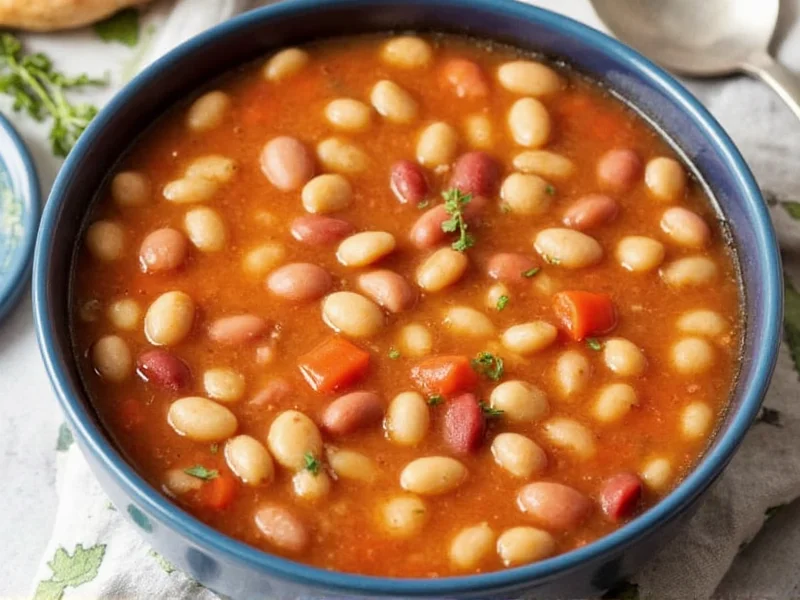There's a reason bean soup remains a kitchen staple across cultures: it transforms simple, affordable ingredients into deeply satisfying meals. When prepared in a slow cooker, bean soup reaches its full potential through gentle, extended cooking that develops flavors while preserving bean texture. This guide reveals professional techniques for creating exceptional crockpot bean soup that avoids common pitfalls like mushy beans or bland broth.
Why Slow Cooking Transforms Bean Soup
Unlike stovetop methods that risk uneven cooking, the crockpot's gentle, consistent heat allows dried beans to hydrate gradually while maintaining structural integrity. The extended cooking time—typically 6-8 hours on low—creates complex flavor development through the Maillard reaction and enzymatic breakdown of starches. Professional chefs favor this method because it requires minimal supervision while producing restaurant-quality results.
Essential Components of Perfect Crockpot Bean Soup
Creating exceptional bean soup requires understanding each component's role. Forget canned beans—dried varieties provide superior texture and absorb flavors more effectively.
Bean Selection Matters Most
Choose beans based on desired texture and cooking time:
| Bean Type | Cooking Time | Best For |
|---|---|---|
| Cannellini | 6-7 hours | Creamy texture, Italian-inspired soups |
| Great Northern | 5-6 hours | Classic American bean soup |
| Black Beans | 7-8 hours | Southwestern flavors, thicker broth |
| Pinto Beans | 6-7 hours | Tex-Mex variations, earthy flavor |
Aromatic Foundation
The flavor base makes or breaks your soup. Combine:
- 1 large diced onion (yellow or sweet)
- 2 diced carrots (¼-inch pieces)
- 3 celery stalks, finely chopped
- 4 garlic cloves, minced
- 2 bay leaves
- 1 tsp dried thyme
These ingredients should fill about one-third of your crockpot before adding beans and liquid. The slow cooking process extracts maximum flavor from these aromatics without burning.
Step-by-Step Crockpot Bean Soup Method
Preparation (10 minutes)
- Rinse 1 pound dried beans thoroughly in cold water
- Sort through beans to remove any stones or debris
- Chop all vegetables to uniform sizes for even cooking
- Place all ingredients except salt in crockpot
Cooking Process (6-8 hours)
- Cook on LOW for 6-8 hours (never HIGH for dried beans)
- Check at 5-hour mark: beans should be tender but not falling apart
- Add 1-2 teaspoons salt during final hour of cooking
- Remove bay leaves before serving
Avoid These Common Crockpot Bean Soup Mistakes
Even experienced cooks make these errors that compromise your easy crockpot bean soup recipe:
- Adding salt too early: Salt prevents beans from softening properly. Always add during the final hour.
- Using canned beans: They turn to mush during extended cooking. Dried beans maintain better texture in slow cooker bean soup.
- Overfilling the crockpot: Never fill beyond two-thirds capacity to prevent boil-overs.
- Adding acidic ingredients early: Tomatoes or vinegar added at the beginning slow bean softening significantly.
Flavor Variations for Every Preference
Customize your vegetarian crockpot bean soup or add meat options based on dietary needs:
Vegetarian Version
Replace meat with 1 sheet of kombu (dried kelp) for umami depth. Add 1 tablespoon nutritional yeast during the final hour for savory notes. This healthy slow cooker bean soup variation delivers rich flavor without animal products.
Traditional Meat Version
Add 1 smoked ham hock or 4 ounces diced salt pork. Remove meat after cooking, shred, and return to soup. The collagen in these cuts creates a luxurious mouthfeel in your crockpot white bean soup or other varieties.
Storage and Reheating Guidelines
Properly stored crockpot bean soup becomes even more flavorful. Follow these freezer-friendly bean soup recipe practices:
- Cool completely before storing (within 2 hours of cooking)
- Store in airtight containers with 1-inch headspace for expansion
- Refrigerate for up to 5 days or freeze for 6 months
- Reheat gently on stove—avoid boiling which breaks down beans
Nutritional Benefits of Bean Soup
A single serving (1½ cups) of properly prepared crockpot bean soup typically contains:
- 250-300 calories
- 15-18g protein
- 10-12g fiber
- Rich in folate, iron, and magnesium
The slow cooking process increases nutrient bioavailability while maintaining resistant starch content that supports gut health. This makes crockpot bean soup an excellent choice for how long to cook bean soup in crockpot while maximizing nutritional value.
Expert Tips for Flavor Mastery
Elevate your crockpot bean soup from basic to extraordinary with these professional techniques:
- Finish with acid: A splash of sherry vinegar or lemon juice just before serving brightens flavors
- Texture contrast: Reserve ½ cup cooked beans, mash, and stir back in for thicker broth
- Flavor layering: Brown meat and vegetables before adding to crockpot for deeper flavor
- Herb infusion: Tie fresh herbs in cheesecloth for easy removal after cooking











 浙公网安备
33010002000092号
浙公网安备
33010002000092号 浙B2-20120091-4
浙B2-20120091-4